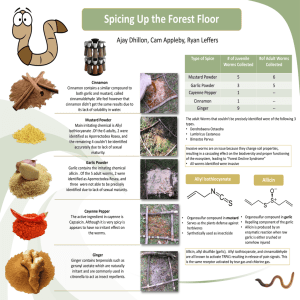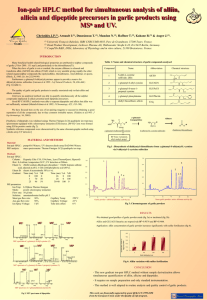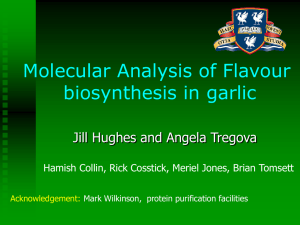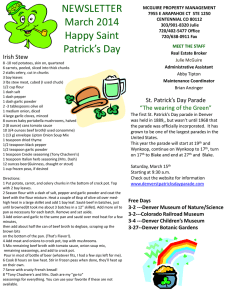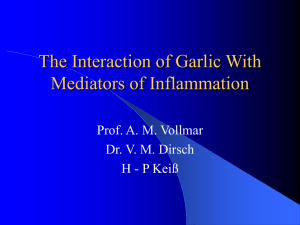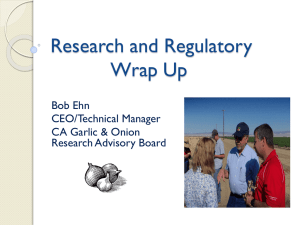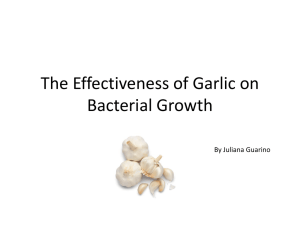EFFICACY OF GARLIC AS AN ANTHELMINTIC IN DONKEYS
advertisement
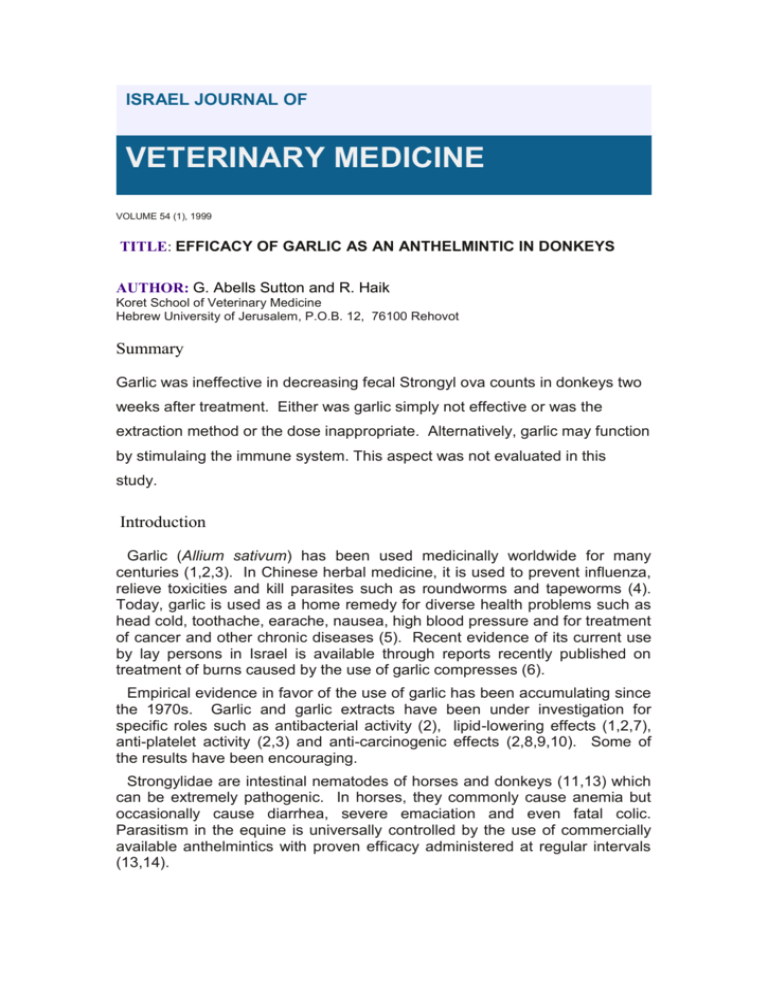
ISRAEL JOURNAL OF VETERINARY MEDICINE VOLUME 54 (1), 1999 TITLE: EFFICACY OF GARLIC AS AN ANTHELMINTIC IN DONKEYS AUTHOR: G. Abells Sutton and R. Haik Koret School of Veterinary Medicine Hebrew University of Jerusalem, P.O.B. 12, 76100 Rehovot Summary Garlic was ineffective in decreasing fecal Strongyl ova counts in donkeys two weeks after treatment. Either was garlic simply not effective or was the extraction method or the dose inappropriate. Alternatively, garlic may function by stimulaing the immune system. This aspect was not evaluated in this study. Introduction Garlic (Allium sativum) has been used medicinally worldwide for many centuries (1,2,3). In Chinese herbal medicine, it is used to prevent influenza, relieve toxicities and kill parasites such as roundworms and tapeworms (4). Today, garlic is used as a home remedy for diverse health problems such as head cold, toothache, earache, nausea, high blood pressure and for treatment of cancer and other chronic diseases (5). Recent evidence of its current use by lay persons in Israel is available through reports recently published on treatment of burns caused by the use of garlic compresses (6). Empirical evidence in favor of the use of garlic has been accumulating since the 1970s. Garlic and garlic extracts have been under investigation for specific roles such as antibacterial activity (2), lipid-lowering effects (1,2,7), anti-platelet activity (2,3) and anti-carcinogenic effects (2,8,9,10). Some of the results have been encouraging. Strongylidae are intestinal nematodes of horses and donkeys (11,13) which can be extremely pathogenic. In horses, they commonly cause anemia but occasionally cause diarrhea, severe emaciation and even fatal colic. Parasitism in the equine is universally controlled by the use of commercially available anthelmintics with proven efficacy administered at regular intervals (13,14). In Israel, many horse and donkey owners consider garlic as a viable alternative to commercial anthelmintics. It is readily available, appears to improve the health of the animals and is perceived to cost less than commercial preparations. There is some evidence to support this practice. Garlic has been reportedly successful in reducing parasitism by Capillaria spp. in carp (15) and as a mosquito larvacide (16). Efficacy of a parasite control program can be evaluated by documenting reduction in the herd average fecal egg counts one to two weeks after treatment. This is carried out on populations of individuals since the variation in fecal egg counts in an individual can vary greatly (13,17,23,24). The main objective of this study was to determine whether a garlic treatment method commonly used in Israel to treat horses and donkeys is efficacious as an anthelmintic against Stongylidae in donkeys. Materials and Methods Thirty six donkeys from one farm were included in the study. The donkeys were not on a commercial anthelmintic program. Their ages were estimated by descriptions of dental wear and growth (11). Their weights were estimated by the use of a formula which incorporates the height and chest circumference of each individual (12). The donkeys were randomly divided into three groups of twelve. Most of the donkeys were females. Seven donkeys were under 2 years of age. These were randomized separately as a block to ensure equal distribution among the groups. One group was left untreated as a negative control. A second group was treated with a standard anthelmintic as a positive control. The third group was treated with garlic. Fecal ova counts The Cornell-McMaster dilution egg count technique was used (13). Fecal samples were taken directly from the rectum of each animal. The fecal counting was carried out in a blind fashion; the group of origin was unknown at the time of the counting. Ten grams of feces was suspended in 150 ml of water. All fecal counts were carried out twice and then compared for repeatability (precision) by plotting them on a graph which tests how well the replicate egg counts fit the Poisson distribution. If the technique is carried out correctly, the repeated counts should follow a Poisson distribution (13). Square roots of egg counts were then used in all subsequent calculations since square root transformation of a Poisson variable converts the variance to a near constant for all but very low values of the variable, and since root egg counts are symmetrically distributed about a mean for all but very low values while egg counts per gram is skewed (13). Also, use of square roots converts integer results into continuous data allowing for a normal distribution and parametric analysis. Anthelmintics Fenbendazole (Panacur®) suspension was used as the well established anthelmintic in the positive control group. The dosage was 7.5 mg/kg and it was administered orally. Garlic was prepared by boiling 300 ml. of water for every head of garlic until soft . The product was then mashed and administered orally with a syringe at the dosage of one head of garlic per donkey. Experimental design Samples were taken one week prior to treatment, on the day of treatment and two weeks thereafter. Statistical analysis The average of the square roots of the two pretreatment fecal counts (T -1 and T0) were tested for normality by the Wilk-Shapiro/rankit plot. The groups were then tested for similar means in age, weight and initial fecal ova counts by one-way ANOVA. The average of the square roots of the pretreatment fecal counts were then compared with the post-treatment sample by using a two-tailed paired Students t-test to determine whether the post-treatment samples were significantly different from the pre-treatment sample within each group. The two factor ANOVA was used to determine whether there was a difference in the fecal egg counts between the groups due to the treatment or due to age (adult vs. juvenile). The Tukey (HSD) test was then applied to determine which of the groups had a mean that was different from the other groups. All statistical calculations were performed by Statistix® software. Results Table 1 shows the age and weight of each donkey in each of the three treatment groups. The pretreatment fecal egg counts were > 300 eggs per gram indicating that the minimal parasite load required for anthelmintic evaluation was present (17). All the fecal egg counts had reasonable repeatability showing that the technical performance of the fecal egg count calculation was reliable (data not provided). The average number of the two counts is recorded in Table 2. Table 1: The estimated age (years) and weight (wt) (kg) of each indivual donkey in each treatment groups. weight estimates are +/- 20 kg if > 2 years of age and +/10 kg if < 2 years of age. Control Group ID No. Age Fenbendazole Group Wt ID No. Age Wt Garlic Group ID No. Age Wt 6 6.5 142 4 4.5 165 1 7 165 7 5 160 5 3.5 110 2 5 187 8 7 127 9 2 131 3 3 165 13 7 142 10 3.5 130 11 7 120 17 7 117 14 7 185 12 25 135 22 7 136 15 4 152 16 4.5 132 24 3.5 148 19 12 120 18 5 122 25 4 140 20 7 154 21 7.5 150 27 5 146 26 7 117 23 3.5 160 29 7/12 59 28 7 195 32 1 134 33 1.5 119.5 30 1 94 34 8/12 59 36 1.5 47.5 31 1.5 120 35 4 157 mean 4.5 124 mean 5 139 mean 6 140.5 Table 2: Number of eggs per gram of feces for each individual donkey (ID#) in each treatment group, one week prior to treatment (T1), On the day of treatment (T0), and two weeks post treatment (T2). Control Group Fenbendazole Group Garlic Group ID No. T1 T0 T2 ID No. T1 T0 T2 ID No. T1 T0 T2 6 100 125 150 4 75 350 0 1 100 7 175 200 325 5 25 75 0 2 1025 275 225 8 225 325 100 9 125 225 0 3 350 350 500 13 125 175 75 10 200 675 0 11 50 17 500 325 600 14 575 0 0 12 425 1050 22 225 600 900 15 350 250 0 16 600 625 1750 24 325 750 325 19 1125 150 0 18 75 25 125 800 850 20 600 875 25 21 150 550 625 27 75 150 475 26 0 0 0 23 475 400 1300 29 800 100 50 28 75 175 0 32 700 375 125 33 75 175 950 30 425 275 0 34 50 75 0 36 NA 150 50 31 75 250 0 35 100 100 75 25 0 100 150 0 0 75 Statistical Analysis The Wilk-Shapiro/rankit plot supported the assumption of normality of the pretreatment pooled data by a p value of 0.9808. The one way ANOVA showed that there was no statistically significant difference in the means of any of the treatment groups for the factors of age, weight and initial fecal ova counts. The p value for age was 0.6692, for weights was 0.3848, and for initial fecal ova counts was 0.8486. The mean fecal counts of both the control group and the garlic group two weeks after treatment were 404. The mean fecal count of the fenbendazole group two weeks after treatment was 2. The mean fecal counts of the control group and the garlic group increased two weeks after treatment compared to the average of the pretreatment counts by 116 and 69 respectively. The mean fecal count for the fenbendazole group dropped by 289 two weeks after treatment. A two-tailed paired Students t-test demonstrated that only in the fenbendazole group were the post-treatment fecal ova counts significantly different from the pre-treatment counts. The p value was p=0.3207 for the control group, p=0.0000 for the fenbendazole group and p=0.8577 for the garlic group. The two factor ANOVA showed a difference in the means of the groups (at p=0.0000) for treatment, but not for age (p=0.0815). The Tukey (HSD) test showed that only the fenbendazole group was significantly different from the other two groups at a rejection level of 0.001. Discussion In Israel, garlic is considered by some horse and donkey owners to be an efficacious method to control internal parasites. Owners report that the treated individuals appear to improve in weight, coat quality and general wellbeing. The main purpose of this study was to investigate a commonly used method which was found to be totally ineffective in reducing the herd egg count of strongyle spp. This is a significant finding because the use of garlic as an anthelmintic, by this method, could endanger the health of the animals in two ways; by replacing an effective means of controlling parasitism with an ineffective method, thereby exposing the individuals to a potentially fatal disease, and by administration of a potentially toxic substance (8). Garlic is a member of the onion family (Allium) and as such can cause methemoglobinemia, although this has not been reported in horses (18). Another possible toxic effect is the theoretical contribution of garlic compounds containing active thiol groups in the development of pemphigus (19). The failure of garlic as an anthelmintic (13,17) may have been due to the method used to prepare the garlic, the dose administered, the method of evaluating the outcome, or that garlic has no anthelmintic effect at all. Many reports describe ways of preparing garlic extract, and many studies have attempted to find the major extract which produces the desired effect (1,8,15,20). Recently, the consensus is that organosulfur compounds are responsible for the medicinal effects of garlic (1,8,10). The most significant of these compounds is allicin (2), which is not actually found in the garlic until it is crushed. Upon crushing, the precursor of allicin, known as alliin, is enzymatically converted by alliinase to allicin (2,21,22). Allicin is extracted in the organic layer of raw garlic homogenate. It can be found in dry garlic powder (20) and can also be synthesized in the laboratory (22). Allicin was found to be the active compound in many of the cases where a medicinal effect was recorded. The molluscicidal (20), antiplatelet (3), lipid-lowering agent (1), and the antibacterial effects (2) have been attributed to allicin. Allicin can disable two groups of enzymes (dehydrogenases and cysteine proteinases) which provide infectious agents with the means to damage and invade tissues. The more significant reported mechanism is due to the chemical modification of the free SH group of L-cysteine in an S-thiolation reaction which inhibits the cysteine proteinase enzyme activity in a reversible reaction (22). Allicin is also responsible for the characteristic odor of garlic (8). It is, however, unstable (8), and is destroyed by boiling (2). In this study the garlic was boiled, so as to follow the method used by horse owners, despite the fact that the allicin was likely destroyed in the process. Therefore, the ability of crushed garlic containing allicin to have anthelmintic properties cannot be ruled out by this study. minced garlic, which contains large amounts of allicin, was reportedly effective in reducing parasite egg counts in carp infected with Capillaria spp (15). An additional explanation for the lack of demonstrable effect by the garlic in this study, may be because the method used to evaluate the outcome may not have been appropriate. Despite its many limitations, the method used in this study is the classical method for the evaluation of the efficacy of new anthelmintics in eliminating ova-laying parasites (13,17,23,24). However, if the mode of action of garlic is not by pharmacological elimination of adult parasites, but rather by enhancing the immunological reaction of the host to the parasites, then the method used in this study would not have been appropriate to demonstrate success. Recent research on the anticarcinogenic effect suggests that garlic enhances natural immunity (25). If there were an immunologically based anthelmintic action of garlic, further studies including a series of treatments would be required. Also, more post treatment measurements may need to be taken over a longer period of time than carried out in this study. Additional research would be desirable since there remains the possibility that allicin may be a successful anthelmintic. Since there is increasing resistance by both large and small strongyles to modern control methods (14,26), new control methods are being sought. The potential toxicity of garlic, however, must not be ignored. In summary, horse and donkey owners should be warned regarding the results of this study in order to prevent the use of an ineffective anthelmintic program which could lead to unnecessary pain and suffering of animals. Further studies, however, may reveal a method of garlic use which would be an effective herd anthelmintic. Acknowledgments: Dr. Hilliary Voet for statistical advice. Avner Maduel and Shemi Bar-Natan of the Shefa Bateva Donkey Farm - The Farm for Donkey Rides, for providing the experimental animals. References: 1. Silagy, C. and Neil, A.: Garlic as a lipid lowering agent-a meta-analysis. J. of the Royal College of Physicians of London 28(1): 39-45, 1994. 2. Dausch, J.G. and Nixon, D.W.: Garlic: A review of its relationship to malignant disease. Prevent. Med. 19: 346-361, 1990. 3. Petry, J.J.: Surgically significant nutritional supplements. Plast. Reconst. Surg. 97(1): 233-240, 1996. 4. Bensky, D. and Gamble, A.: Herbs that expel parasites. In: Chinese Herbal Medicine: Materia Medica. Eastland Press Inc., Seattle, Washington. pp. 441-444, 1993. 5. Brown, J.S. and Marcy, S.A.: The use of botanicals for health purposes by members of a prepaid health plan. Res. in Nurs. Health. 14: 339-350, 1991. 6. Farrell, A.M. and Staughton, R.C.D.: Garlic burns mimicking herpes zoster. Lancet 347: 1195, 1996. 7. Warshafsky, S., Kamer, R.S. and Sivak, S.L.: Effect of garlic on total serum cholesterol. A meta-analysis. Ann. Intern. Med. 119: 599-605, 1993. 8. Dorant, E., van den Brandt, P.A., Goldbohm, R.A., Hermus, R.J.J. and Sturmans, F.: Garlic and its significance for the prevention of cancer in humans: a critical view. Br. J. Cancer 67: 424-429, 1993. 9. Singh, S.V., Mohan, R.R., Agarwal, R., Benson, P.J., Hu, X., Rudy, M.A., Xia, H., Katoh, A., Srivastava, S.K., Mukhtar, H., Gupta, V. and Zaren, H.A.: Novel anti-carcinogenic activity of an organosulfide from garlic: inhibition of H-RAS oncogene transformed tumor growth in vivo by diallyl disulfide is associated with inhibition of p21H-ras processing. Biochemical and Biophysical Research Communications 225: 660-665, 1996. 10. Stavric, B.: Role of chemopreventers in human diet. Clin. Biochem. 27: 319-332, 1994. 11. Whitehead, G., French, J. and Ikin, P.: Welfare and veterinary care of donkeys. In Practice 3: 63-68, 1991. 12. Eley, J.L. and French, J.M.: Estimating the body weight of donkeys. Vet. Rec. 132: 250, 1993. 13. Bowman, D.D.: In: Georgis' Parasitology for Veterinarians, W.B. Saunders Co. Philadelphia, pp 177-184, 298-301, 1995. 14. Austin, S.M.: Large strongyles in horses. Comp. Cont. Ed. 16(5): 650655, 1994. 15. Peסa, N., Aurא, A. and Sumano, H.: A comparative trial of garlic, its extract and ammonium-potassium tartrate as anthelmintics in carp. J. Ethnopharmacol. 24: 199-203, 1988. 16. Amonkar, S.V. and Reeves, E.L.: Mosquito control with active principle of garlic, Allium sativum. J. Economic Entomol. 63: 1172-1175, 1970. 17. Uhlinger, C.A.: Uses of fecal egg count data in equine practice. Comp. Cont. Ed. 15: 742-748, 1993. 18. Galey, F.D.: Plants and other natural toxicants. In: Smith, B.P. (ed.): Large Animal Internal Medicine. 2nd edition. Mosby Year-Book, Inc. Missouri. p. 1888, 1996. 19. Brenner, S. and Wolf, R.: Possible nutritional factors in induced pemphigus. Dermatol 189: 337-339, 1994. 20. Singh, V.K. and Singh, D.K.: Characterization of Allicin as a molluscicidal agent in Allium sativum (garlic). Biological Agricul. Horticul. 12: 119-131, 1995. 21. Singh, V.K. and Singh, D.K.: Molluscicidal activity of pre- and postharvest Allium sativum (garlic). Biological Agricul. Horticul. 12: 311-318, 1996. 22. Ankri, S., Miron, T., Rabinkov, A., Wilchek, M. and Mirelman, D.: Antimicrobial Agents and Chemotherapy. 41: 2286-2288, 1997. 23. Uhlinger, C.A. and Kristula, M.: A field evaluation of three methods of administration of anthelminthics to horses. Equine Vet. J. 24(6): 487-488, 1992. 24. Musgrave, I.A., Hawes, R.B., Jameson, J.L., Sloane, R.A. and Quayle, P.A.: Mebendazole: Evaluation of a new anthelmintic for trichuriasis, hookworm and strongyloidiasis. Med. J. Aust 1: 403-405, 1979. 25. Riggs, D.R., DeHaven, J.I. and Lamm, D.L.: Allium sativum (Garlic) Treatment for Murine Transitional Cell Carcinoma. Am. Cancer Soc. 79:1987-1994, 1997. 26. Bird, J. and Herd, R.P.: Nematophagous fungi for the control of equine cyathostomes. Comp. Cont. Ed. 16: 658-665, 1994.
